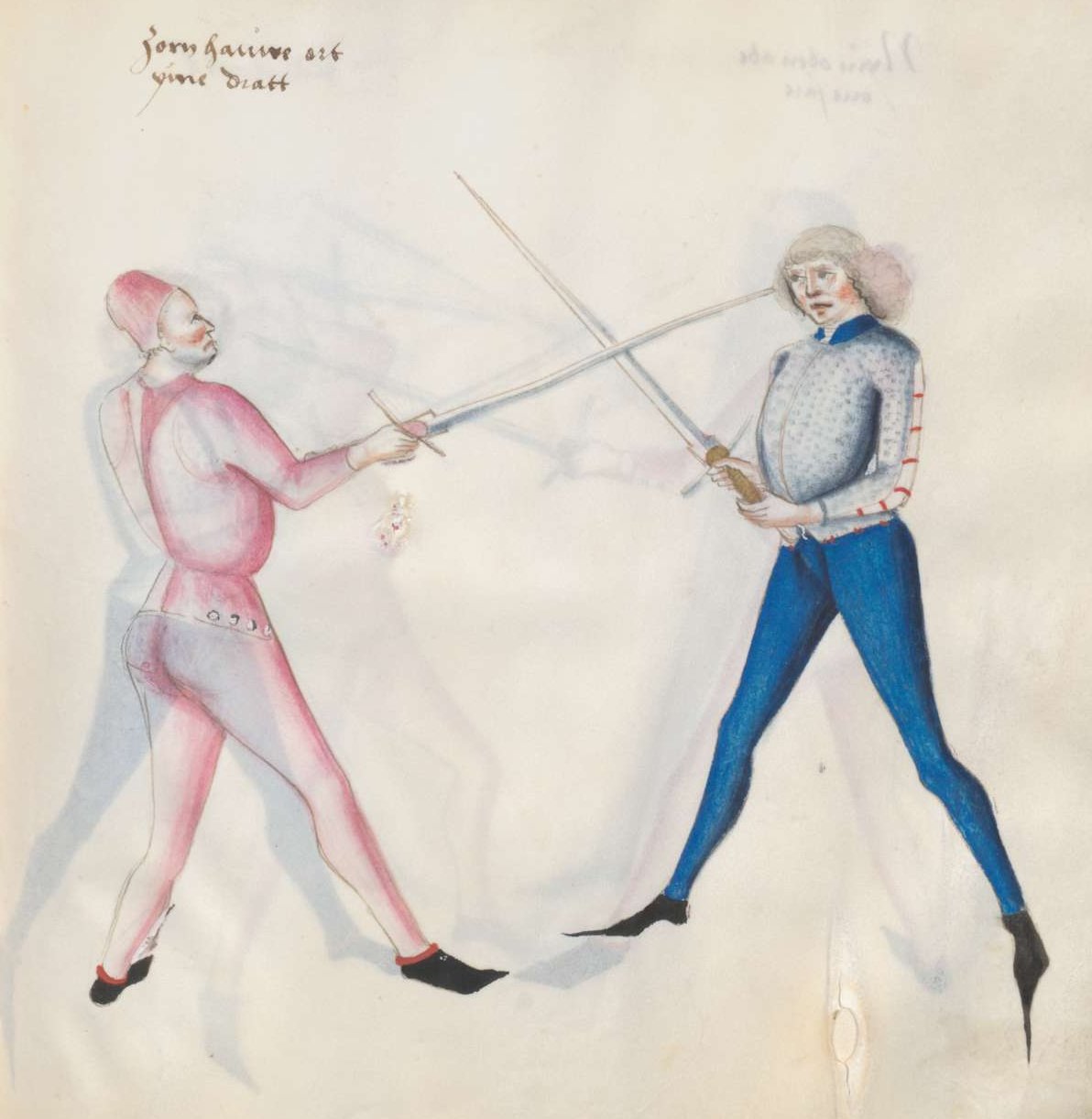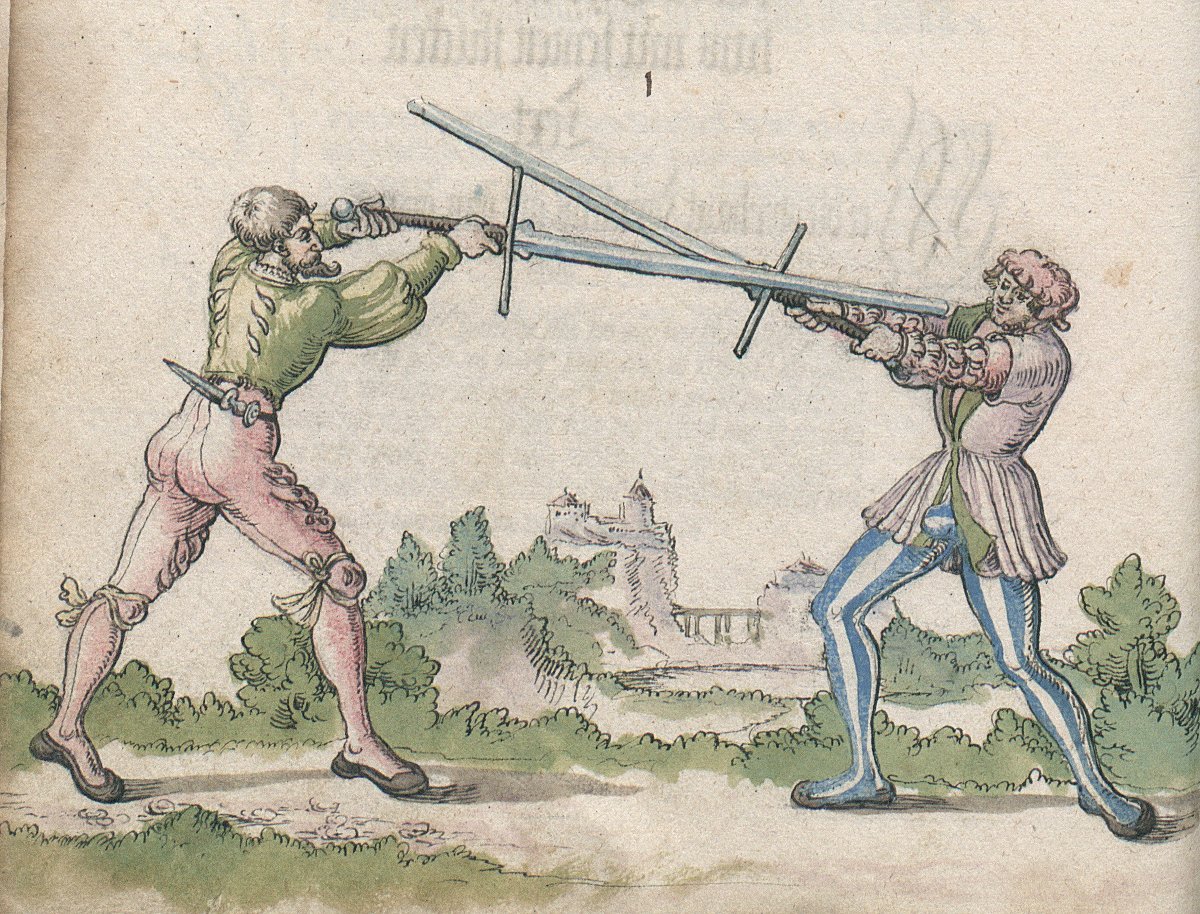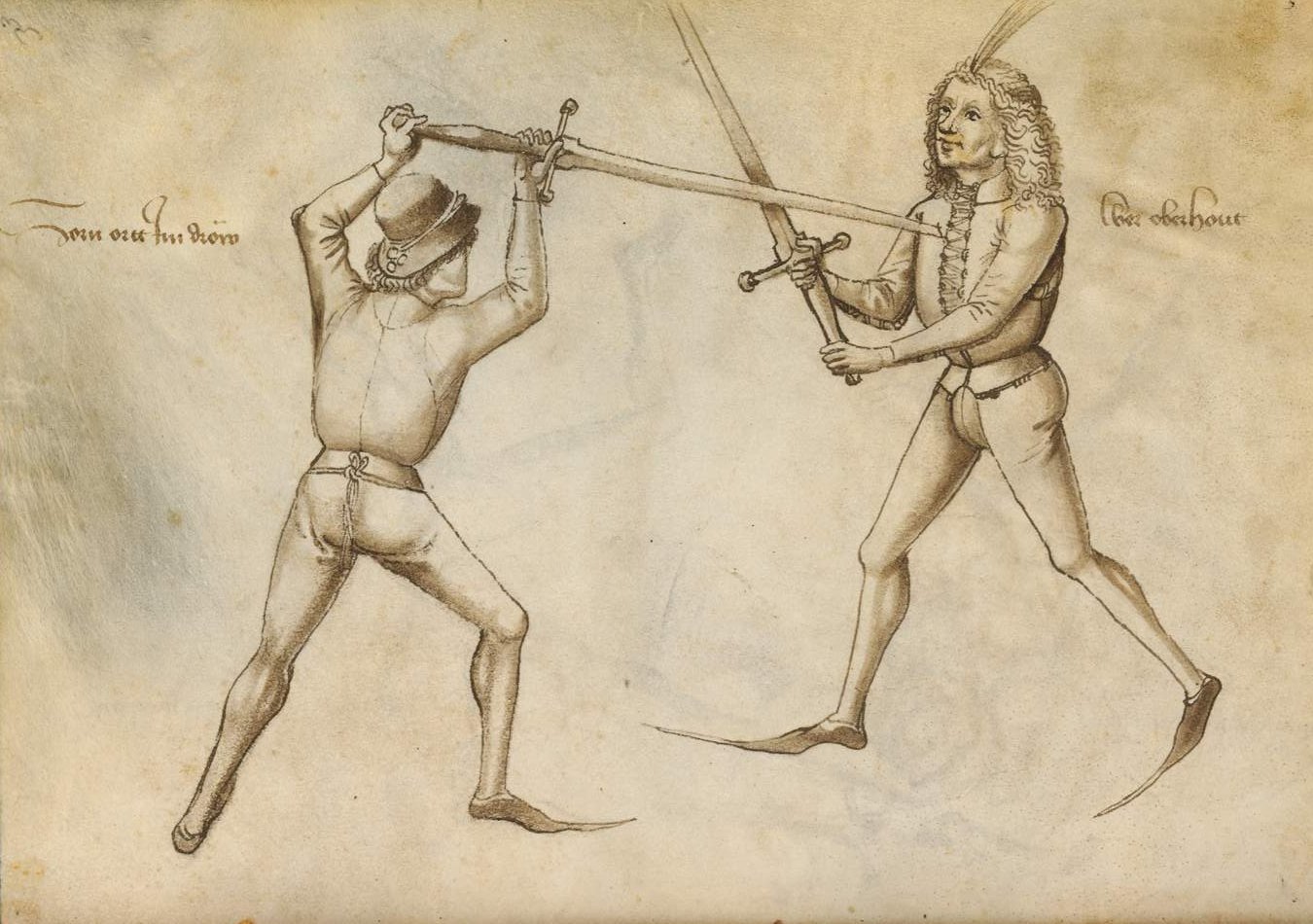Zornhau ort
Zornhaw ort is the very first technique described in Lichtenauer’s Kunst des Fechtens. It’s sometimes considered as the most basic piece of the Zedel and therefore often overlooked. But it certainly deserves the same attention as more popular techniques like Zwerch or Schiller.
Das ist der zorn haw mitt sinen stucken
Haůt er dir den von seiner rechten seiten oben ein zů dem kopff, so haw aůch von deiner rechtenn von oben an alle versatzůng mit im zorniglichen einn aůf sein schwert, ist er dann waich am schwert, so scheůs im den ort gericht fůrsich lanckh ein vnd stichh im zů dem gesicht, oder der průst vnd setz im ann
If your opponent is cutting you from his right side to your head so cut him also from you right side from above without parrying strongly on his sword. If he is then weak on the sword throw your point forwards and thrust him into his face or chest.
Analyses and Interpretation
If we look at various descriptions of the Zornort all authors use the term Zornhaw without explaining properly how to perform a Zornhaw. It is assumed that reader is already familiar with basics1 like this. We can deduct from quite brief texts (even without knowing about Hs. 3227a) that Zornhaw is a cut from above downwards usually performed from the right shoulder. Therefore, we assume it’s a slant or diagonal cut. As Peter von Danzig (or better the author of Codex 44.A.8) describes Zornhaw as nothing more than a direct2 peasant strike which breaks with his point all high cuts. Some authors like Sigmund Ringeck misses the remark that you should strike without parrying which I find quite substantial. Without this information, all interpretations end in two tempi parry-riposte action where a defender is trying to beat the opponent’s upper cut to side, across the center line, followed by a direct thrust. Similar interpretations are still quite popular and we did it similarly back in the 2009 as you can see in our very first video. I found this way suboptimal and such execution is nothing extraordinary. I would not include such a primitive technique into 5 hidden cuts (later named as master cuts). If something was mentioned among those 5 hidden cuts it was supposed not to be known by common fencers. And parry-riposte with an Oberhau and a direct thrust is so common that it could be barely hidden or unknown. Therefore, I think Lichtenauer had something much better on his mind when he made Zornort his first explained technique.
Some manuscripts demand that attacker should be weak/soft after the swords clash together but some other texts do not mention this requirement.
In our interpretation, the Zornhaw is almost a vertical cut, slightly skewed but far less diagonal than some people like. The goal is to hit the opponent along the centerline of his body, either to his face, throat or chest. My target is always directly behind opponent’s hands. If they are higher I hit him higher to the face or the throat. If he performs a bit lower Oberhau my point lands lower, to his chest or the stomach. (You can see both versions later in our video)
My sword hits the opponent’s blade more or less from above. Not from the side. It must not be about clashing of two diagonals cuts together. Otherwise, it would be only about the strength and height. My sword should always follow the centerline and the point must not leave it. During the Zornhaw I knock the opponent’s blade off the centerline and I remain there with my blade, dominating the space between me and my opponent. The attacker’s Oberhau is deflected and because of the body rotation, I stay covered behind my blade. I can say we finish up the technique in a position very similar to the one depicted on the picture #1. But very roughly.

Image #1: Zornhaw ort, Paulus Kal
I’d strictly advise not to cut the Zornhau to the left side against the incoming blow. My primary strategy is not to parry as some glosses say. Zornhaw should all the time occupy the centerline. Because once you cross it to either side it’s quite difficult to regain it back. And if your opponent keeps it, you are lost.
In order to win the centerline, I have to be quite educated in body rotations mechanics. I need the support from the whole body. Starting in the rear toe through the hips into my arms and finishing in the point of my sword. It was quite popular to use the word “rotation” in HEMA but I am convinced in many cases without deeper comprehension. It was sometimes used as a magic word or mantra but often without real results.
The rotations during the Zornort should not be a simple horizontal rotation in shoulders or hips. Otherwise, the vector of my power tends to leave the desired trajectory and I will end up with my Zorn and point cutting to the left side and I won’t be able to use single tempo potential of Zornhau ort. You could imagine the power generation as a rotation in a spiral manner starting in the rear leg, making a loop through the hips and flowing directly towards the opponent’s chest. This goes from below upwards to the center. Another rotation goes from above downwards and meets the previous one in the center. This one starts in the left-hand goes through the shoulders and delivers the cut with leading right shoulder. Of course, a body is not a spiral and you do not have to follow this description, but it can help someone to realize how the body sides are switching their roles. For the Zornhaw, the left hip and left shoulder are in the front. In the end, the right shoulder and right hip take the lead. But upper and lower body should move separately, not like one block.
There are some important points I always recommend to perform. Your rear leg should be always firmly fixed to the ground from the very first moment of Zornort. It’s a painful mistake to start Zornort attempt during unfinished movement backwards. Without this fixed point I won’t be able to push my weight forwards, and without the movement of my pelvis forward I cannot transfer so much energy to my blade. In the impact moment, I am pushing my right hip forwards as much as possible and left one stays a bit backwards. This motion brings a slight rotation to my upper body and therefore I will be covered behind my blade.
I hit the opponent’s blade with long edge slightly to his flat. Definitely not against the edge. I prefer to hit it with the CoP3 to the middle of his strong part of the blade. Closer to the middle than to the cross guard. Arms should be slightly bent in the elbows and shoulders relaxed and low. The closer the opponent is, the lower and more bent hands I use.
Have you ever noticed that in the Zornort texts there is no note about steps or movement? Do you prefer to step forward at the same time with your Zorn? I don’t. In case I lack the reach I use one following passing step slightly to the right side but it’s quite usual that I don’t have to use any step at all and the opponent stuck himself on my point during his own leap forwards. If the opponent is too close, I can hit him even without thrust just by cutting with point to his head. (The last sequence in the video) If you go with passing step with the Zornhau, then the cut lacks the support from the ground. Because in the most important moment, your feet are in the air. And vice versa if you are strongly pushing to your rear foot during the blade contact, your hips are moving forwards above your front foot and you can source the energy/power from the ground. Your legs will be always stronger than your arms and working with all limbs unison is the only way how to resist and how to defeat stronger and more athletically gifted peers.
If the opponent cuts too high, I often do not find a proper lower opening so I need to raise my arms, eventually, I can wind them into Ochs position and hit him to the face from above. But in this case, we are sacrificing the one tempo action. These actions are at least similar to positions depicted on pictures #2 and #3. There is almost no mention about using reverted Ochs position in Zornort although most survived illustrations show it like the picture #3. The only remark is mentioned in Ringeck’s appendix4 to the longsword’s teachings.

Image #2: Ms. Germ. Quart 2020 (vysokú pozíciu rúk najdete aj v interpretačnom videu v zaverečných sekvenciách)

Image #3: Obrázok 3: Hans Talhoffer (Cod.icon. 394a)
Video interpretation
Common Mistakes
Proper timing
As always in fencing, the timing is essential also in the Zornhau ort. If both fencers start at the same time it can cause that the defender won’t be able to win the centerline or to find the target with the point. In the case when both are moving forwards at the same time the space between fencers shortens twice so fast. It’s very hard to aim properly to the desired target when moving forwards. It’s desired to start a bit later however this is a usual problem only in training conditions. Keep in the mind that starting with Zorn too early gives the opportunity to your opponent to change his cut easily. But if you wait for the latest possible moment his sword will have a momentum which he can hardly change.
Strong vs. weak
Sources say that Zornort requires that opponent should be weak on the blade. Unfortunately, no master describes clearly what does it really mean in detail. I would assume that a weak opponent does not cut without power but he does a cut which follows the original line all the time and his cut has an intent to make at least some wound. He must not change the line of strike to my blade, which is a very common mistake during drills or even in free plays. People do not believe they can succeed with the Vorschlag and they anticipate opponent’s counter. Their cuts are then actually parries instead of attacks.
In that case I am not able to threaten him with my point and the Zorn ort would be useless. Instead of stretching arms forward (it would give my opponent my Schweche and the control over the centerline) I would choose another technique e.g. Oben Abnehmen or something more appropriate.
Wrong oberhau
It may happen that sometimes the defender receives a hit by the attacker’s Vorschlag even if he does everything almost as described above. He does proper rotation, he dominates the centerline and thrusts the opponent but at the same time, he receives a hit to the head. The problem could be that the attacker was never trying to cut through the centerline and he cuts too much from the side instead. Therefore, the Zornort which cleans only the centerline does not eliminate the threat. How to solve the situation? One possible solution would be to change direction of the Zornhau to the left side but then it would be kind of parry instead of fancy master cut. I think there is a better and direct solution. I should punish the mistake of the opponent, because he is not cutting directly along the shortest possible way. What should I then do? To cut simple and direct Zornhaw but not to his sword. This would be a mistake as his sword is in not in the center. I should do a Zornhaw with the same trajectory as before but this time there won’t be a blade at the usual impact point. His hands should be waiting there instead. I know it’s quite usual we do not want to cut full speed Zornhaw into the opponent’s (but still a friend’s) hands. In a real fight this would stop his Vorschlag by cutting his hand off but now it’s impossible to train it even in modern HEMA gloves. Better to learn him how to strike an Oberhaw properly.
Suboptimal version
https://www.youtube.com/watch?v=mjT4JepA-Vc - Dvojtemopové neoptimálne riešenie ako sme to videli v roku 2009.
https://www.youtube.com/watch?v=d4ClauDNAfg
https://www.youtube.com/watch?v=2r00EMOWYXk
https://www.youtube.com/watch?v=DdLFXsptzhg
https://youtu.be/6ainzFa7mHc?t=20s
https://www.youtube.com/watch?v=Rg3S5SEEnnc
https://www.youtube.com/watch?v=Ha0vpW9DS2s
Training tips
We completely refactored our Zornort approach several times. It does not mean it’s perfect now, but it’s the most comfortable and most efficient version I have tried in many years. Many interpretations fulfil the original texts and it is not possible to say which one is the only and correct way of Zornort execution. And I strongly believe it was so also back in the fifteenth century. There was probably no uniform Zornort across all countries of Lichtenauer’s tradition. So if you find our more straightforward interpretation appealing you can also try our way of training it.
We are trying to use similar methodology with all more complex techniques. There is always one master and student in the pair. Even if both of them are beginners. Each technique is practised in different layers or phases. In each layer, we add just one thing to focus on. If the master is satisfied with a trainee, he raises the level of the exercise in the next layer. If the trainee has hard time to perform all the required things for the particular layer, the master switches back to the previous layer.
Levels of Zornort exercises:
-
Rotation without a weapon. Left foot forward and left shoulder is leading. Rotation starts with pressure on the right foot toe. Rear leg pushes the centre of gravity forwards above the tip of the front foot. Leading side changes during the motion. Right shoulder leads now and the left stays a bit behind. Both legs are stretching to the full extent.
-
Exercise with weapon. Similar to the previous one. There is one more impulse now; (in addition to the rear foot) to the left hand. Trainee should pull the pommel downwards with the left hand. Right hand follows the motion. The sword ends at centerline in langort with shoulder and elbows relaxed.
-
Cutting opponent’s sword aside without thrusting. The goal is to clear centerline. Master is cutting an uppercut in symbolic way. Without real intention.
-
Full Zornort against light cuts. No steps are allowed. Focus on proper fixed position. Keep your CoG low.
-
Zornhau ort against full cut from static position and fixed distance. Master should regularly check if the trainee does not cut the Zornhau off-line. He should combine lighter and faster cuts with stronger and slower ones. Trainee can from time to time try not to counter with Zornhau in order to find out if the master is still aiming for the head properly.
-
Zornort against an advancing opponent. The master is moving only forwards and pushing against the defender. (You need ideally 20m long free line) Once master decides to start with Oberhau, the defender should stop moving backwards and immediately fix the rear foot to the ground. Otherwise he won’t be able to resist master’s cut.
-
The opposite situation to the previous exercise. Master is retreating and trainee is following him. They are moving in the fixed distance and when the master finds out the situation is suitable he stops motion backwards and strikes his Oberhau. Trainee keeps on his momentum and smashes the opponent’s cut with his Zornhau. When the distance is close enough he hits the opponent’s head directly with the Zornhaw. This exercise should be combined with pure Zornhau. If the retreating master doesn’t keep proper distance and doesn’t cut, the opponent is obliged to cut Zornhaw in Vor to the head without waiting for Nach.
-
Zornhau ort against all types of uppercuts with full footwork. Various angles, speed and distance. The master is simulating free play conditions.
We use quite often one old fencing aid. A visual target on master’s body. It can be a small dot or a cross made from a duct tape. Fencers often do not have exact idea where should their sword end. They make a cut and then they just want to place to point where it’s possible. The opposite approach seems more efficient to me. I lock my sight on the target even before my opponent starts his action. It helps me keep my sword traveling directly to the desired target without hesitation. The very same approach I use also in free plays and the result are more committed and more precise attacks.
I feel it’s necessary to add a video illustrating all these exercise sometimes in the future. We plan to bring you more videos with training sequences where you can faster get the idea how should each exercise looks like.
-
“das sÿ ydermann wol vernemen vnd versten mag der do anders fechten kan” ↩︎
-
schlecht = not crooked, Deutsches Wörterbuch von Jacob Grimm und Wilhelm Grimm ↩︎
-
“Wann ainer von dach vff dich schlöcht So schlach den zorn haw mitt der langen schniden alß er dir gewyst ist Jn sinen schlag an sin schwert mitt der langen schnid dines schwerts Vnd wind im din ort an von stund an mitt zů sinem angesicht mitt vermugen daß ist mitt störck. (57r)” ↩︎
